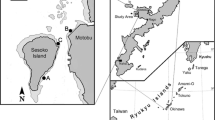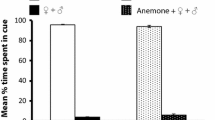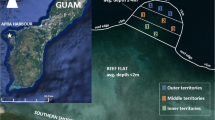Abstract
The olfactory cues, to which some species of anemonefish embryos imprint, are secreted in the mucus on the tentacles and the oral disc of the host anemone. Close contact of the eggs of anemonefishes with the host's tentacles seems therefore important to imprinting. A corollary of this observation is that if local environmental conditions sweep tentacles in one specific direction, then the eggs will be placed leeward of the tentacles, rather than to foremost way from the tentacles. Other known factors such as egg predation can also cause a spawning site preference. No study has examined the possibility of the existence of such a preference. In this study, we addressed two questions: (1) Does spawning site preference exist in anemonefishes? (2) If yes, is it possible to relate this to the imprinting hypothesis, i.e. does local ocean currents over the host anemone have any influence on this preference? Two different coral reef areas were surveyed for anemonefish groups with eggs present: Eilat and Na'ama in the Aquaba-bight, the Red Sea (RS), and areas at Lizard Island, the northern Great Barrier Reef (GBR). We found the anemonefishes Amphiprion akindynos (GBR), A. bicinctus (RS), A. melanopus (GBR), and A. perideraion (GBR), to have a distinctive spawning site preference. We discuss the relevance of these findings to anemonefish host imprinting.
Similar content being viewed by others
References cited
Allen, G.R. 1975. The anemonefishes. Their classification and biology, 2nd ed. T.F.H. Publications, Neptune City. 352 pp.
Arvedlund, M. & L.E. Nielsen. 1996. Do the anemone-fish Amphiprion ocellaris (Pisces: Pomacentridae) imprint themselves to their host sea anemone Heteractis magnifica (Anthozoa: Actinidae)? Ethology 102: 197–211.
Arvedlund, M., M. McCormick, D.G. Fautin & M. Bildsøe. 1999. The anemonefish Amphiprion melanopus (Bleeker) (Pisces: Pomacentridae): a study of host detection and possible imprinting. Mar. Ecol Prog. Ser. 188: 207–218.
Bell, L.J. 1976. Notes on the nesting success and fecundity of the anemonefish Amphiprion clarkii at Miyake-jima, Japan. Japan. J. Ichtyol. 22: 207–211.
Dunn, D.F. 1981. The clownfish sea anemones. Stichodactylidae (Coelenterata: Actinaria) and other sea anemones symbiotic with pomacentrid fishes. Trans. Amer. Phil. Soc. 71: 1–115.
Elliott, J.K., J.M. Elliott & R.N. Mariscal. 1995. Host selection, location, and association behaviors of anemonefishes in field settlement experiments. Marine Biology 122: 377–389.
English, S., C. Wilkinson & V. Baker (ed.). 1997. Survey manual for tropical marine resources, 2nd edition, Vol. 1. Australian Institute of Marine Science, Townsville. 390 pp.
Fautin, D.G. 1991. The anemonefish symbiosis: what is known and what is not. Symbiosis 10: 23–46.
Fautin, D.G. & G.R. Allen. 1992. Field guide to anemone-fishes and their host sea anemones, 1st ed. Western Australian Museum, Perth. 160 pp.
Fischelson, L. 1965. Observations and experiments on the Red Sea anemones and their symbiotic fish Amphiprion bicinctus. Bull. Sea Fish. Res. Stat. 39: 1–14.
Fricke, H.W. 1974. Öko-Ethologie des monogamen Anemonen-fisches Amphiprion bicinctus (Freiwasseruntersuchungen aus dem Roten Meer). Z. Tierpsychol. 36: 429–512.
Job, S., M. Arvedlund & M. Marnane. 1997. Culture of coral reef fishes. Austasia Aquacult. 11: 56–59.
Konno, K., G. Qin & K. Nakanishi. 1990. Synthesis of Amphikuemin and Analogs: a synomome that mediates partner-recognition between anemonefish and sea anemones. Heterocycles 30: 247–251.
Miyagawa, K. & T. Hidaka. 1980. Amphiprion clarkii juvenile: innate protection against and chemical attraction by symbiotic sea anemones. Proc. Japan. Acad. 56(B): 356–361.
Miyagawa, K. 1989. Experimental analysis of the symbiosis between anemonefishes and sea anemones. Ethology 80: 19–46.
Moyer, J.T. 1980. Influence of temperate waters on behaviour of the tropical anemonefish Amphiprion clarkii at Miyake-jima, Japan. Bull. Mar. Sci. 30: 261–272.
Moyer, J.T. & L.J. Bell. 1976. Reproductive behavior of the anemonefish Amphiprion clarkii, of Miyake-Jima, Japan. Japan. J. Ichtyol. 23: 23–32.
Moyer, J.T. & R.C. Steene. 1979. Nesting behavior of the Anemonefish Amphiprion polymnus. Japan. J. Ichtyol. 26: 209–214.
Murata, M., K. Miyagawa-Koshima, K. Nakanishi & Y. Naya. 1986. Characterization of compounds that induce symbiosis between sea anemone and anemonefish. Science 234: 585–587.
Ross, R.M. 1978. Reproductive behavior of the anemonefish Amphiprion melanopus on Guam. Copeia 1978: 103–107.
Zar, J.H. 1996. Biostatistical analysis, 3rd ed. Prentice-Hall, Upper Saddle River. 662 pp.
Author information
Authors and Affiliations
Rights and permissions
About this article
Cite this article
Arvedlund, M., Bundgaard, I. & Nielsen, L.E. Host Imprinting in Anemonefishes (Pisces: Pomacentridae): Does it Dictate Spawning site Preferences?. Environmental Biology of Fishes 58, 203–213 (2000). https://doi.org/10.1023/A:1007652902857
Issue Date:
DOI: https://doi.org/10.1023/A:1007652902857




